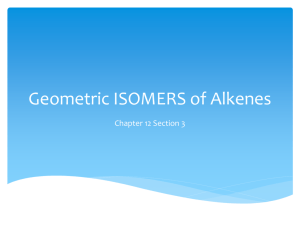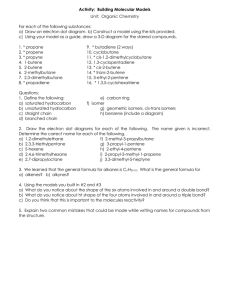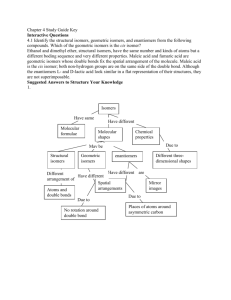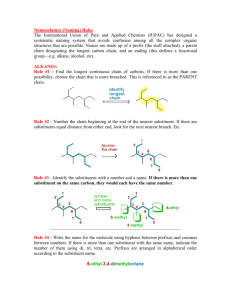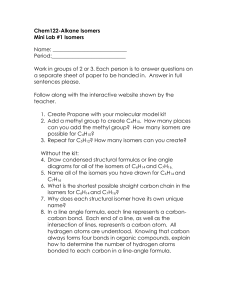Organic Chemistry - mvhs
advertisement
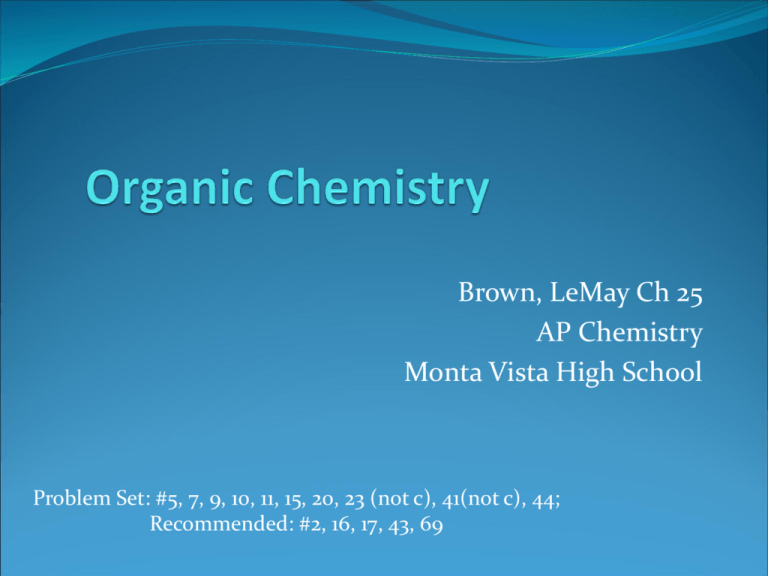
Brown, LeMay Ch 25 AP Chemistry Monta Vista High School Problem Set: #5, 7, 9, 10, 11, 15, 20, 23 (not c), 41(not c), 44; Recommended: #2, 16, 17, 43, 69 25.1: Organic Chemistry The study of carbon compounds, but not limited to living systems Biochemistry: study of the chemistry of living things Hydrocarbons are Compounds composed of only C and H Combust to form CO2 and H2O Hydrocarbons have a -parent carbon chain: It is the longest continuous carbon chain (does not have to be straight) - and a side substituent: Ex: alkyl groups 2 25.2: Intro to Hydrocarbons Types: 1. Alkanes: contain only single C-C bonds. General formula Cn H2n+2, ending -ane Also called saturated (contain the maximum # of H’s) Ex. Methane, Ethane etc. Unsaturated: contain < maximum # of H’s 2. Alkenes: contain at least one C=C bond. General Formula CnH2n, ending - ene 3. Alkynes: contain at least one C≡C bond. General Formula CnH2n-2, ending - yne 4. Aromatics: C’s connected in a planar ring (contain s and p bonds) and have delocalization. Contain benzene ring, ex: benzene, chlorobenzene 3 Organic Nomenclature prefix base suffix What substituents? What “family”? How many carbons in longest chain? Originally formulated by IUPAC in 1892 (http://www.acdlabs.com/iupac/nomenclature/) 1. Find the longest continuous chain of C atoms; use the name of this chain as the base of the compound’s name. This is called the parent carbon chain. 1 = meth= hex- 2 = eth3 = prop- 4 = but- 5 = pent-6 7 = hept- 8 = oct- 9 = non- 10 = dec4 2. Number the C atoms in the longest chain, beginning with the end nearest to a substituent. If different substituents are present, give the lowest number to the substituent with highest priority (see list on the website). The idea is to number the parent carbon chain to give the side substituents the lowest numbering. Priority List: carboxylic acid> aldehyde> ketone>alcohol> double or triple bond> alkyl group http://www.chem.ucalgary.ca/courses/351/orgnom/functional/func.html 5 3. Name and give the location (carbon #) of each substituent as prefixes or suffixes. (It varies.) 4. When 2 or more substituents are present, name them in alphabetical order as prefixes When 2 or more of the same substituents are present, use a Greek prefix (di-, tri-, tetra-, penta-, hexa-, …) Examples: Saturated hydrocarbons Alkanes: CnH2n+2; suffix is -ane Cycloalkanes: CnH2n (n>2); prefix is cyclo C’s bonded in a ring; not planar like an aromatic compound (except cyclopropane) Ex: Draw Lewis structures of the first 4 cycloalkanes and name them. cyclopropane cyclobutane cyclohexane 7 Ways to represent Organic Compounds Molecular Formula Ex: C4H10 condensed formula Ex: H3C–CH2–CH2–CH3 or CH3CH2CH2CH3 CH3CH2CH2CH3 Structural formula Ex: 8 Understanding Check Draw condensed formula and structural formula for the following: C3H8 Ex: Name all the molecules. methane CH4 C2H6 ethane C3H8 propane C4H10 butane C5H12 2-methylpropane pentane 2,2-dimethylpropane 2-methylbutane 10 Write the name of the following: ______________________ ______________________ ______________________ ______________________ ______________________ _______________________ ______________________ ______________________ Draw condensed structural formulas for the following hydrocarbons: •2,3-dimethylpentane •2,4-dimethylhexane •Cyclohexane •2,2-dimethylpropane •2,4-dimethyl-1-hexene •2,4,6-trinitromethylbenzene •cis-2,3-dichloro-2-butene •1,1,2-trichloroethane •1,2-methylcyclohexane •1,4-dichlorobenzene •1-chloro-2-butyne •1,3-cyclohexadiene 25.4 – 25.5: Functional Groups Notation: “R” stands for: Alkyl group, such as H -CH3 -C2H5 -C3H7, etc. Carbonyls: contain a C=O 15 Name of Formula group of group Carboxylic acid Suffix Name O || R-C-OH Example structure Example chemical name methanoic acid -oic acid or “R-COOH” O || R-C-O-R Ester or “R-COOR” ethyl propanoate -yl ___oate propyl ethanoate Aldehyde O || R-C-H or “R-CHO” Ketone O || R-C-R -one R-O-H -ol (suffix if highest priority) Alcohol or “R-OH” -al 2-methylbutanal 2-butanone hydroxyl(prefix if lower priority) 2,3-pentadiol diethyl ether Ether R-C-O-C-R ___ ether NH2 Amine R-NH2 -amine NH2 2,2-pentadiamine \ Alkene / C=C / \ Alkyne R-C≡C-R Halide R-X -ene -yne halo(bromo-, chloro-, fluoro-, iodo-) 1-propene 2-butyne 2-bromopropane Cycloalkene C ring with cyclodouble ___-ene bond(s) Cycloalkane cyclo___-ane C ring 1-cyclopentene cycloheptane -yl Alkane (as -(CH2)nfunctional CH3 group) or -ane 2,3-dimethylbutane Isomers: Compounds with same molecular formula but different structures (different bonding arrangements) There are two main types of isomers: 1. Structural Isomers: Same formula but differ in the arrangement of atoms around the carbon chain. Structural isomers can be: a. branched chain (depending on C chain) b. positional (position of a side group) c. functional group isomers (position of a functional group). 2. Stereoisomers: Same formula but different 3-D orientation. They can be of two types: a. Geometric Isomers ( cis, trans, double bonded C atoms only) b. Optical Isomers (3D- orientation different- chirality) 21 Ex: Draw all the structural isomers for... CH4 C2H6 C3H8 C4H10 C5H12 22 25.4: Geometric Isomers (cis-trans) Alkenes: CnH2n; prefix is bond #; suffix is –ene (more than one double bond: –diene, -triene) Geometrical isomers: same formula & same groups, but different structures. cisgroups with highest priority on same side of bond axis (high priority = high atomic mass) transgroups with highest priority diagonal/across the double bond Ex: Draw and name all the isomers of C4H8. y y x x 23 The essential requirement for this stereoisomerism is that each carbon of the double bond must have two different substituent groups (one may be hydrogen). This is illustrated by the following general formulas. In the first example, the left-hand double bond carbon has two identical substituents (A) so stereoisomerism about the double bond is not possible (reversing substituents on the right-hand carbon gives the same configuration). In the next two examples, each double bond carbon atom has two different substituent groups and stereoisomerism exists, regardless of whether the two substituents on one carbon are the same as those on the other. Credits: http://www2.chemistry.msu.edu/faculty/reusch/VirtTxtJml/sterisom.htm Optical Isomers Two molecules are optical isomers if they are non super imposable, mirror images of each other. http://www.wellesley.edu/Chemistry/Flick/chem341/opticalisomers.html Credit: Google Images *25.7: Chirality Chiral: a molecule having a nonsuperimposable mirror image (Originally discovered by Louis Pasteur) Compounds containing C atoms with four different substituents are inherently chiral Optical isomers or enantiomers: nonsuperimposable mirror images Labeled “L” (levo, left-handed) and “D” (dextro, right-handed) Racemic: a mixture containing both enantiomers (both L and D) http://nobelprize.org/educational_games/chemistry/chiral/ 26 Alkynes: CnH2n-2; prefix is bond #; suffix is –yne Reactions: unsaturated molecules are more chemically reactive than saturated compounds Addition: H3C-C≡C-CH3 + Br2 → ? Br―Br → H3C-C=C-CH3 | | Br Br Hydrogenation: CH3-CH=CH-CH3 + H2 → ? H―H → H3C-CH―CH-CH3 | | H H 27 Aromatics: named like alkanes, but primarily based on benzene Prefix describes relative positions of substituents: ortho2 substituents next to each other meta2 substituents separated by one C para2 substituents separated by two C’s ortho- meta- para- Naphthalene: “mothballs” 28


